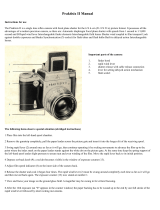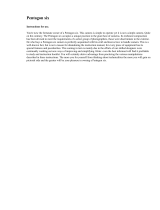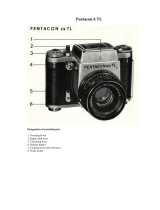Page is loading ...

Praktisix Manual
Instructions for use
The Praktisix is a single lens reflex camera with focal plane shutter for the 6 X 6 cm (21/a X 21/ ") picture format. It
possesses all the advantages of a modern precision camera, as there are:
Fully automatic diaphragm
Focal plane shutter with speeds from 1 second to 1/1,000 second and B
Rapid wind lever
Interchangeable finder elements
Interchangeable field lenses
Shutter wind coupled to film transport
Lock against double exposures and blanks Synchronization (X-contact) for flash tubes and flash bulbs
Built-in delayed action
Interchangeable lenses
Please pay special attention to the following items (abridged instructions)
1 Place film into the left-hand spool chamber.
2 Remove the gumstrip completely, pull the paper leader across the picture gate and insert it into the longer slit of
the receiving spool. The coupling slit of the spool must be at the upper end.
3 Swing rapid lever (2) around once as far as it will go, then continue operating it by rocking movements to advance
the film to the point where the arrow mark on the paper leader stands against the white dot on the picture gate. At the
same time keep the spring support of the left-hand spool under slight pressure to assure taut and even winding of the
film. Move the rapid lever back to its initial position.
4 Depress set-back knob (9); a red dot becomes visible in the window of exposure counter (13).
Important parts of the camera
1 finder hood
2 rapid wind lever
3 shutter release knob with cable release
connection
4 lever for setting delayed action

5 Adjust film speed indicator (8) on the inner side of the camera back.
6 Release the shutter and cock it began four times. The rapid wind lever (2) must be swung around completely each
time as far as it will go and then moved back again. The exposure counter (13) now stands at number 1.
7 View and focus your image on the ground glass field. A magnifier may be swung in for critical focusing.
8 After the 12th exposure (an "E" appears in the counter window) the paper backing has to be wound up to the end
by one full stroke of the rapid wind lever followed by short rocking movements.
Not only of these items of course, but the complete instructions for use must be studied carefully.
6 Latch for camera back
7 Knob for opening the finder
hood
8 Film speed indicator
9 Set back knob for exposure
counter

A surface coated mirror reflects the image designed by the lens onto the ground glass screen. At the moment of the
exposure the mirror is swung out the path of rays and, forming a light tight cover over the ground glass, allows the
light rays to pass freely on to the image plane. As soon as the mirror has reached its topmost position, the shutter is
opened for the exposure. Taking lens and finder lens being one and the same, there is no danger of parallax error.
Everything that you see in the viewfinder must necessarily appear on the film, even in extreme close-ups. This
renders it possible to use lenses of various focal lengths and intermediate rings for close-up work without the need
for any extra finder attachments.
Inserting the film
You may use any kind of commercially available 120 roll film Fort 12 exposures 6 X 6 cm (21/ X 21/4 "). Undo
latch (6) and open the camera back. Place empty spool into the right hand spool chamber and make sure that the
driving mechanism catches the spool core. The bottom spring support has to be slightly pulled away. The full spool
is inserted into the left-hand chamber in the same manner.
The leader of the protective paper backing must point in the traveling direction of film. Remove the gumstrip
completely, but not before the film is held fast in the spool chamber. Pull the paper leader across the picture gate
(printed side outwards) and fix it into the longer slit of the receiving spool.
Swing the rapid wind lever (2) around as far as it will go and continue advancing the film leader by small rocking
movements until the arrow mark stands against the white dot on the picture gate. Now move the rapid wind lever
back to its initial position. Tight and even winding of the film is absolutely necessary to avoid faulty film feed
periods. The spring support of the full spool should, therefore, be kept under slight pressure as a means of checking
the wind-off movement of the film.
Depress set back knob (9) to bring exposure counter (13) to its starting point. A red dot appears in the counter
window. Release the shutter and cock it again four times. The number 1 now stands in the counter window.

At every subsequent cocking of the shutter, the counting mechanism advances to the next number. After the twelfth
exposure an "E" appears. Actuate the wind lever smoothly and without interruption as far as it will go, move it back
to its original position. Do not let it jump back.
Setting the film speed indicator
A film speed indicator (8) is built into the camera back. It is adjusted from the interior before the camera is closed.
Close the camera back and lock it.
The finder hood
Push the little knob (7) is on the finder hood housing in arrow direction, thus causing the finder hood (1) to spring
into operating position.
The magnifier
For critical focusing and to facilitate picture composition, a magnifying lens (12) yielding a fourfold enlargement
may be swung into parallel position with the field lens.
The sports finder
Lift the inner part of the finder hood cover from the outside. Pull out the little eyepiece frame at the back of the
finder hood. Close the finder hood by fingertip pressure on the cover.
To remove the finder hood from the camera, push it towards the back and lift it off.
The pentaprism
For focusing at eye level finder hood is interchangeable with a pentaprism. The prism reveals the image enlarged
approximately four times and with sides unreversed. Persons with faulty eyesight may insert a corrective lens into
the eyepiece of the viewfinder to replace their spectacles.
Pull the two lateral catches on the pentaprism towards the back and place the prism onto the four connecting pins on
top of the camera. Release the catches, and the pentaprism snaps in. Removing the prism from the camera is
performed accordingly.
Focusing
With the mirror swung into viewing position, rotate focusing ring (20) on the lens mount until the ground glass
image appears sharp. The distance may also be set by the scale (19) is on the lens mount, in which case the ground
glass image serves only for determining picture composition.

Also the depth of definition can be read from the focusing ring. To the left and right of the red indicator are
diaphragm numerals. The distance figures standing against the diaphragm numeral required for the exposure show
the range of definition.
For example:
For a distance setting of five meters (16 feet 8 inches) and a f8 aperture that depth of definition reaches from
approximately 3.5 meters to 10 meters (11 feet 8 inches to 33 feet 4 inches).
When using the sports finder you may either determine the sharpness on the ground glass beforehand or adjust the
focusing scale on the lens mount to the distance estimated or measured.
The rangefinder lens
The two part images in the rangefinder lens are moved towards or away from each other by rotation of the focusing
ring (20). If the outlines join precisely where the two sections meet, the image is in correct focus. This can be
observed best on straight vertical lines.
Exchanging field lenses
Remove the finder element from the camera and then loosen the screws on the three remaining springs with a
screwdriver. Swing the springs aside, take out the spring ring and tip out the lens. Fixing any one of the other field
lenses is performed in reverse order. The thinner part of the lens must lie towards the back of the camera.
Setting the diaphragm
Turn diaphragm setting ring (17) is to bring the diaphragm numeral required for the exposure against the red mark.
Lenses with automatic spring diaphragm and automatic pressure diaphragm allow for full aperture focusing. On
release of the shutter the diaphragm closes to the pre-set aperture.
The shutter
The focal plane shutter gives exposure speeds ranging from one second to 1/1,000 of a second and "B" (any desired
length of time). For exposure speeds longer than 1 second it is advisable to use a special wire release with locking
device.
The speeds are graduated so that each figure indicates double or one half of the speed marked by the next figure on
the scale. The diaphragm scale works in a similar manner. If the light value is to be maintained, the next smaller
aperture has to be employed for twice the exposure time, or vice versa.
Setting the shutter speeds
Rotate speed setting disk (11) in either direction, before after the shutter has been cocked, to bring the desired
exposure speed against the red triangular mark.
The rapid wind lever

Swing the rapid wind lever around to its stop and move back to its original position. The shutter is thus cocked, the
film is advanced by one frame, the diaphragm set to its widest aperture, the exposure counter switched to the next
number and, the mirror having been set, the path is open the light rays to reach the ground glass.
The delayed action
Swing winding lever (4) of the delayed-action mechanism through 90 degrees and actuate release knob (3). The
mechanism runs for approximately 10 seconds and may be employed with all shutter speeds.
The delayed-action lever remains in end the position only if the shutter has been cocked beforehand.
Locking the release nut
Lock the release mechanism by turning the lower milled ring (14) on release knob (3) anticlockwise as far as it will
go. (The red dot must be at the top.) Inadvertent tripping of the shutter is thus impossible. The shutter release
mechanism is freed by turning the ring back again.
Flash synchronization
Synchronization for electronic flash and bulbs is affected by means of the X-contact on the lower part of the camera
front, next to the tripod Bush (5).
For electronic flash, move the shutter speed setting disk (11) to the speed marked by the flash arrow. Longer speeds
may also be used. For short burning bulbs set a shutter speed of 1/15 of a second and for all the longer duration 1/8
of the second. The correct diaphragm setting is found by dividing the guide number of the flash by the flash-to
subject distance figure.
Removing the film
Swing the rapid wind lever around once as far as it will go and continue winding up the paper backing by small
rocking movements until actuating the lever becomes noticeably easier. Only then open the camera back. Fasten the
gumstrip and remove the spool with the exposed film. Films can be exchanged in daylight.
Exchanging lenses
Turn milled ring (15) of the bayonet fitting anti-clockwise until it stops. The lens is now unlocked and can be
removed from the camera. The red mark on the scale of the lens to be inserted must be at the top, and the screw, or
pin, on the inner edge of the lens mount has to engage in the recess of the bayonet fitting in the camera (see arrow in
illustration). To fix the lens tighten milled ring (15) by clockwise movement.

Interchangeable lenses
Standard lenses
Jena Bm 80mm,f2.8 automatic diaphragm
Meyer Primotar E 80mm,f2.8 pressure diaphragm
Supplementary lenses
Jena Flektogon 50mm,f4 automatic diaphragm
Jena Flektogon 65mm,f2.8 automatic diaphragm
Jena Bm 120mm,f2.8 automatic diaphragm
Jena S 180mm,f2.8 automatic diaphragm
Meyer Telemegor 300mm,f4.5 manual pre-set diaphragm
Jena Catadioptric lens 1000mm,f5.6
Standard lenses
The standard Jena Bm lens is equipped with a fully automatic diaphragm, and the Meyer Primotar E with a pressure
diaphragm. The mechanical performance of these two lenses is somewhat different. To check the depth of field on
the ground glass with the Jena Bm lens you exert continuous pressure on lever (16) at the right hand side of the lens

mount. With the Meyer Primotar E on the other hand, the diaphragm setting ring has to be moved from the red mark
to the black mark. The diaphragm thus closes to the pre-set value. As long as the red dot stands against the red
diaphragm index mark the automatic diaphragm mechanism is in operation and the widest aperture will always be
set when the shutter is cocked.
When the black dot on the front setting ring stands opposite the diaphragm index mark, the ground glass image may
be viewed with the diaphragm on pre-set stop.
For the purpose of brightening up to finder image the focusing aperture of the Primotar E is somewhat larger than
0.5, whereas the exposure is made at the actual pre-set opening.
Supplementary lenses
On supplementary lenses not equipped with automatic diaphragm as, for instance, the 300 mm Telemegor f 4.5, you
press the setting ring directly behind the diaphragm scale backwards and adjust it so that its mark stands opposite the
desired diaphragm numeral, where it clicks in.
Preview your image at full aperture and immediately before making the exposure turn the diaphragm ring back to the
pre-selected spot.
When using supplementary lenses with automatic diaphragm you actuate lever (16) is to check the depth of field in
the same manner as described above for the standard lenses. On release of the lever the diaphragm jumps back to its
widest opening. With lenses of a longer focal length the automatic diaphragm lever in the camera may project into
the path of rays and can, therefore, be moved away from its normal position towards the camera body. To achieve
this remove the lens from the camera and swing the lever, which becomes visible on the left side inside the opening,
just far enough that it will not touch the camera body when the shutter is cocked. Swing the lever back into operating
position when automatic or pressure diaphragm lenses are to be used.
Accessories for close-up work
11 Speed setting disk
12 Magnifying lens
13 Exposure counter
14 Locking device for shutter release
15 Milled ring for fixing the lens
16 Lever for checking depth of field
17 Diaphragm setting lever
18 Depth of field scale
19 Distance scale
20 Focusing ring

Set of intermediate rings with special intermediate ring and double cable release Set of intermediate rings with
plunger Close-up bellows attachment Five special type image field lenses Focusing magnifier Special pressure plate
(for working with glass plates) On delivery, these accessories are accompanied by a special instruction booklet --
Equipment for Close-up Photography.
Please read these instructions are use carefully since we can accept no liability for damage caused by improper
handling of the equipment. The details given in this booklet are subject to alterations, which may result for further
development in the manufacturing process.
/





